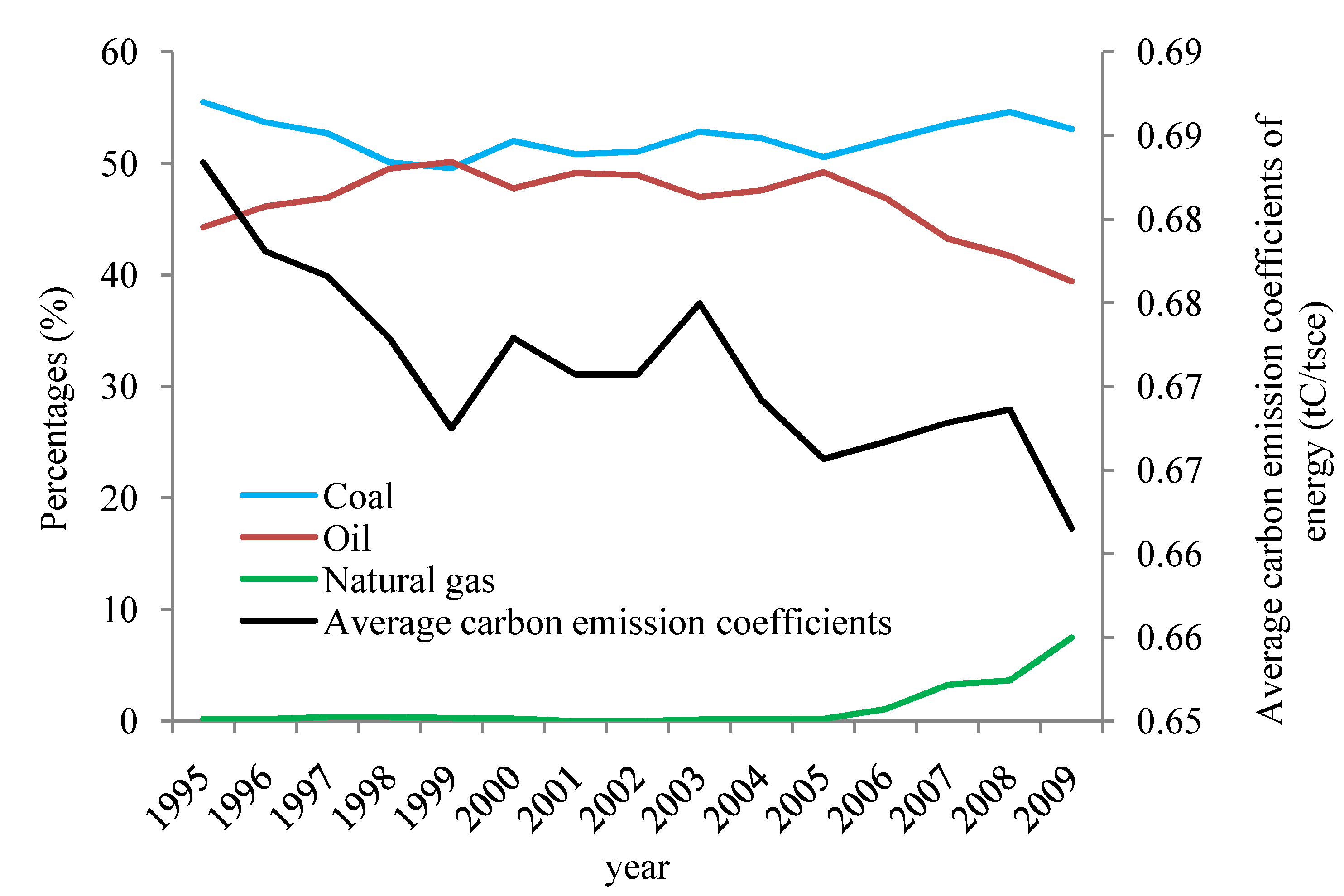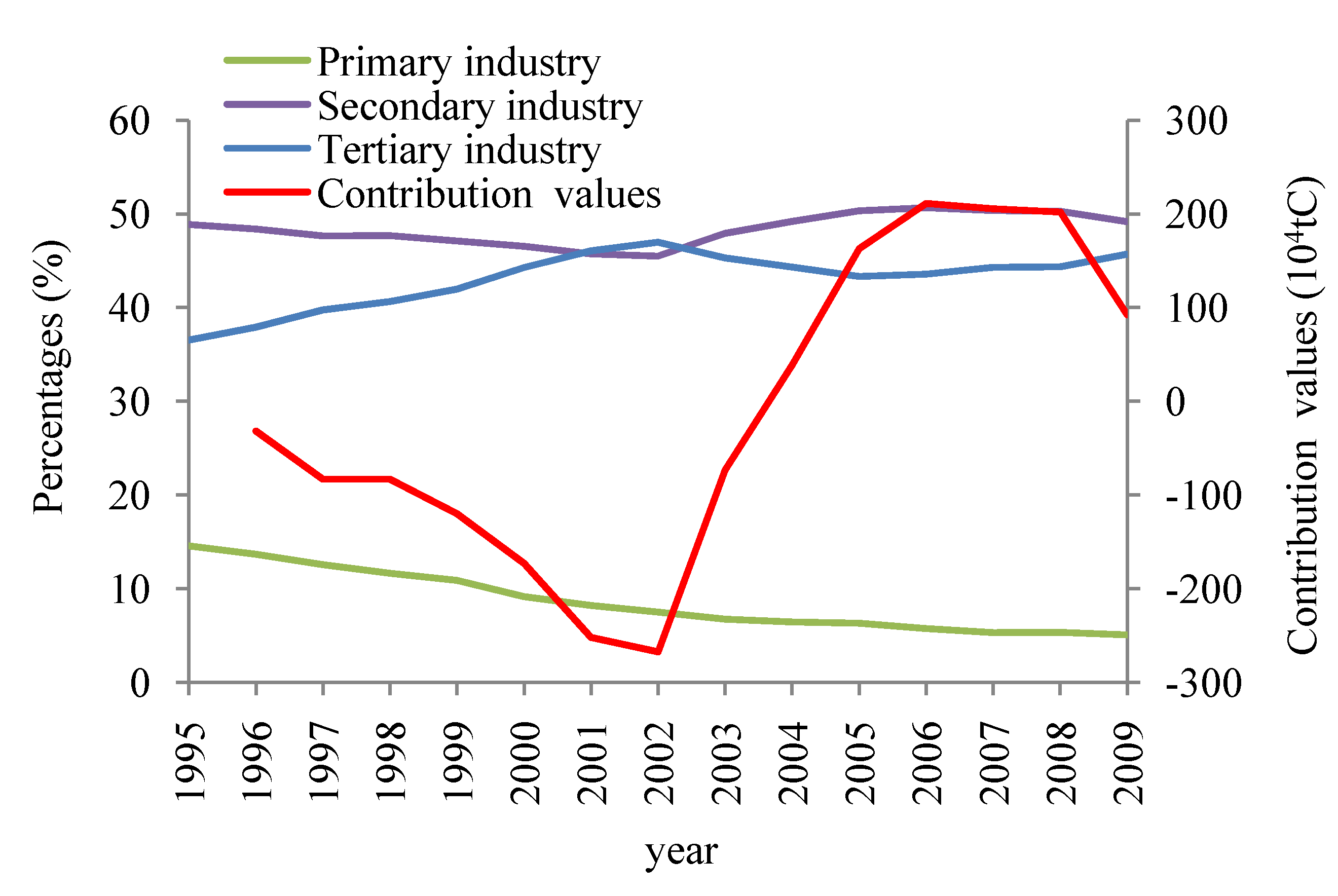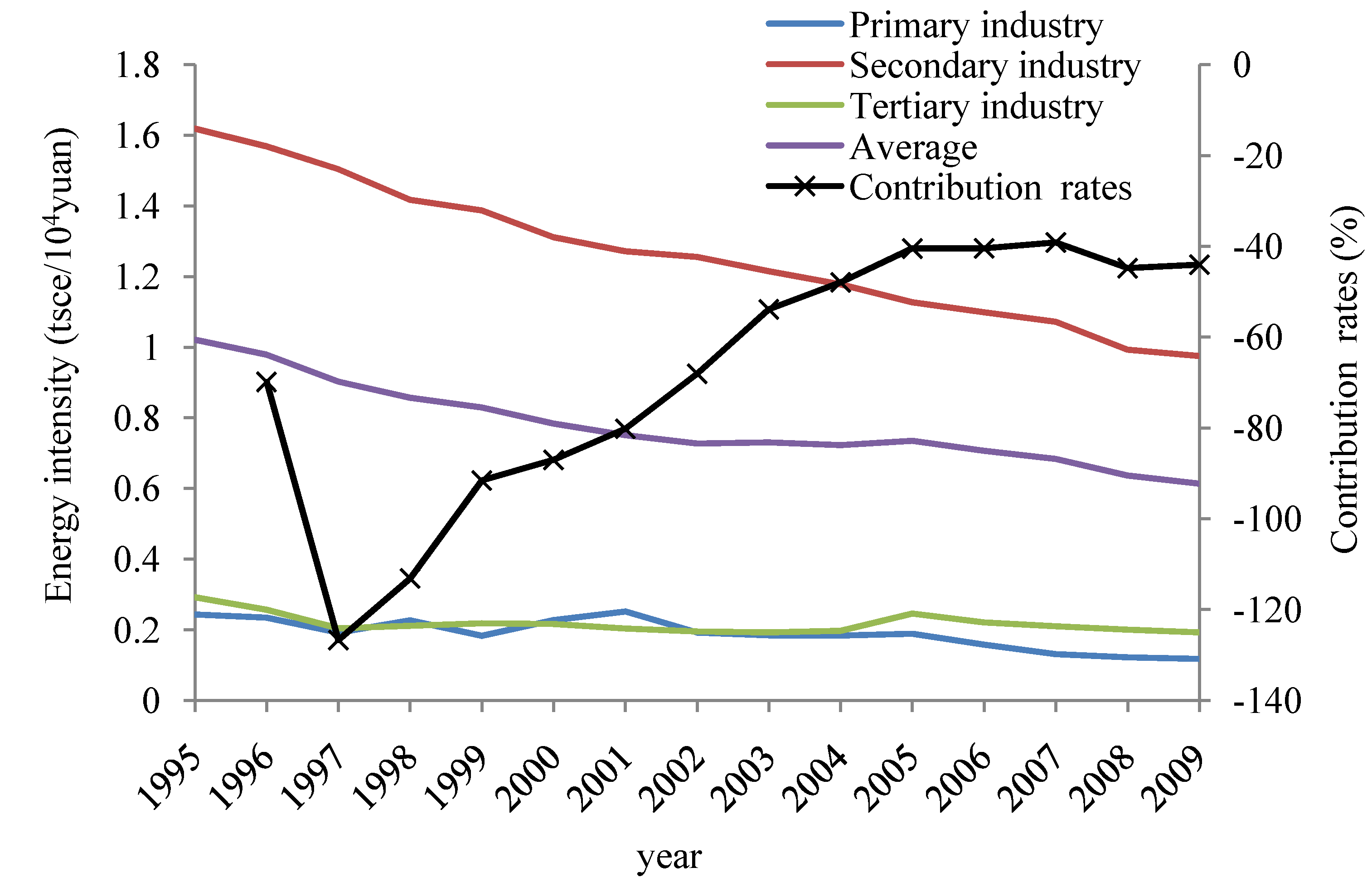3.1. Discussion on the Estimates of Energy-Related Carbon Emissions
The estimated results of energy-related carbon emissions (
Table 2) show that the total energy-related carbon emissions in Guangdong province increased from 4452.44 × 10
4 tC (ton of Carbon) in 1995 to 13007.02 × 10
4 tC in 2009, and the average annual growth rate is 7.96%.For the energy-related carbon emissions from the three strata of industry and household sectors, only energy-related carbon emissions from the primary industry showed decreasing trend, which fluctuate in a narrow range, decreasing from 145.60 × 10
4 tC in 1995 to 120.86 × 10
4 tC in 2009, and the average annual decline rate is 1.32%. The energy-related carbon emissions from the secondary industry, tertiary industry and household show increasing trends, from 3580.04 × 10
4 tC, 403.25 × 10
4 tC and 323.55 × 10
4 tC in 1995 to 10611.96 × 10
4 tC, 1628.49 × 10
4 tC and 645.72 × 10
4 tC in 2009, respectively, and the average annual growth rate are 8.07%, 10.48% and 5.06%, respectively. It is obvious that the secondary industry is the largest source of carbon emissions, which accounts for more than 80% of the total energy-related carbon emissions. End-use in industry and thermal power plants are the two major contributors to carbon emissions in the secondary industry. They acted alternatively as the largest source of carbon emissions. The largest contributor to carbon emissions in tertiary industry is the sector of transport, storage, postal and telecommunication services. Therefore, in the process of carbon emission reduction in Guangdong province, the secondary industry, especially the industrial sector, is undoubtedly the focus of emission reduction. Moreover, carbon emission reduction in tertiary industry, especial in the sector of transport, storage, postal and telecommunication services, cannot be ignored.
Growth rates of economic development and carbon emission during the period 1995–2009 can be seen from
Figure 4. During the period of
9th Five-Year Plan (1996–2000), short for China’s
9th Five-Year Plan for National Economic and Social Development (1996–2000), the Asian Financial Crisis (1997) originated in Thailand made China’s foreign trade export growth rate decreased from 20% in 1996 to 0.5% in 1997, it is undoubtedly was a fatal blow to Guangdong where economic development mainly relies on exports. Meanwhile, some deep-seated contradictions formed in the rapid development of Guangdong since reform and opening up began to surface gradually during this period. Both reasons lead to economic growth rate of Guangdong declining year to year. Until 2000, it began to rise again.
The growth rate of energy-related carbon emissions increased year by year after a sharp drop in 1997. During the execution period of the 10th Five-Year Plan (2001–2005), Guangdong’s economy achieved rapid development by seizing the opportunities of economic globalization; China formally joined the WTO and the international industrial transfer system. The growth rate of the economy reached its highest point (14.84%) in 2003. Driven by the rapid development of the economy, growth rates of energy consumption and carbon emissions increased year by year. At the same time, Guangdong was facing a gradually intensifying situation of domestic and international energy supply and energy price fluctuations, energy development and conservation policy was involved, and the growth rate of energy-related carbon emissions began to decline in the late 10th Five-Year Plan Period. Guangdong’s economy maintained a steady and rapid growth rate in the first two years of the 11th Five-Year Plan Period (2006–2010). The Global Financial Crisis in 2008 once again frustrated the development of Guangdong’s economy, and its economic growth rate dropped significantly compared to 2007. With the implementation of industry and labor “double transfer” policy in 2008, Guangdong’s economic growth rate declined in 2008 and 2009 during the process of industrial restructuring. Guangdong made greater energy conservation efforts to achieve the target to drop the energy consumption per unit GDP by 16% in 2010 compared to that in 2005, resulting in a declining growth rate of carbon emissions, especially in 2008, growth rate of carbon emissions has declined abruptly as compared to 2007.
Figure 4.
Growth rate of GDP and total carbon emissions.
Figure 4.
Growth rate of GDP and total carbon emissions.
Table 2.
Estimation results of energy-related carbon emissions in Guangdong province.
Table 2.
Estimation results of energy-related carbon emissions in Guangdong province.
| Year | Carbon Emission by Sectors (104 tC) | Total Carbon Emissions |
|---|
| Primary Industry | Secondary Industry | | | Tertiary Industry | Household |
|---|
| Total | Industry (End-use) | Power | Heat | Construction | Total | Transport etc. | Wholesale etc. | Others |
|---|
| 1995 | 145.60 | 3580.04 | 1857.16 | 1587.75 | 102.26 | 32.86 | | 403.25 | 313.20 | 61.53 | 28.52 | 323.55 | 4452.44 |
| 1996 | 146.46 | 3811.26 | 1906.58 | 1789.55 | 101.90 | 13.22 | | 406.08 | 331.42 | 58.51 | 16.15 | 348.90 | 4712.71 |
| 1997 | 118.31 | 3987.11 | 2090.25 | 1784.80 | 100.56 | 11.48 | | 375.21 | 310.54 | 53.17 | 11.50 | 338.10 | 4818.73 |
| 1998 | 145.88 | 4134.78 | 2112.48 | 1883.16 | 126.66 | 12.48 | | 447.13 | 382.81 | 51.95 | 12.37 | 315.70 | 5043.49 |
| 1999 | 119.62 | 4374.68 | 2096.12 | 2142.26 | 122.99 | 13.32 | | 516.93 | 457.81 | 56.60 | 2.52 | 319.94 | 5331.18 |
| 2000 | 141.29 | 4610.83 | 1989.96 | 2488.75 | 117.03 | 15.09 | | 600.66 | 526.44 | 58.70 | 15.52 | 307.99 | 5660.77 |
| 2001 | 155.74 | 4839.78 | 2086.73 | 2604.54 | 132.52 | 15.99 | | 649.20 | 569.95 | 62.64 | 16.60 | 330.93 | 5975.65 |
| 2002 | 120.44 | 5337.76 | 2206.13 | 2944.46 | 170.46 | 16.71 | | 709.80 | 615.01 | 75.91 | 18.89 | 331.89 | 6499.89 |
| 2003 | 119.42 | 6276.97 | 3018.44 | 3054.65 | 182.87 | 21.00 | | 781.08 | 689.44 | 70.71 | 20.93 | 372.54 | 7550.01 |
| 2004 | 130.82 | 7080.51 | 2742.14 | 4194.61 | 118.60 | 25.17 | | 898.44 | 793.25 | 81.28 | 23.90 | 392.16 | 8501.93 |
| 2005 | 150.88 | 7919.22 | 3265.99 | 4496.74 | 116.07 | 40.42 | | 1242.15 | 1058.53 | 142.28 | 41.34 | 504.07 | 9816.32 |
| 2006 | 131.67 | 8905.41 | 3958.83 | 4754.06 | 149.00 | 43.52 | | 1288.03 | 1088.22 | 158.36 | 41.45 | 521.77 | 10846.87 |
| 2007 | 116.67 | 9948.80 | 4414.36 | 5289.46 | 197.15 | 47.83 | | 1427.78 | 1199.50 | 181.27 | 47.01 | 588.13 | 12081.38 |
| 2008 | 120.43 | 10188.72 | 4882.21 | 5093.83 | 168.74 | 43.95 | | 1507.96 | 1293.05 | 171.96 | 42.95 | 615.57 | 12432.68 |
| 2009 | 120.86 | 10611.96 | 5354.80 | 4980.43 | 226.14 | 50.58 | | 1628.49 | 1355.13 | 227.53 | 45.83 | 645.72 | 13007.02 |
3.2. Discussion on the Factor Decomposition Results of Energy-Related Carbon Emissions
Results of period-wise analysis (
Figure 5) show that the decomposed factors have an overall increase effect on carbon emissions, of which, the economic output gives the largest contribution to the increase in energy-related carbon emissions during the period 1996–2009. This indicates that the increase of carbon emissions is mainly caused by the increase of total economic output. Energy intensity has a significant reduction effect on energy-related carbon emissions, it is the main inhibitory factor. Other factors show weak effects on carbon emission temporarily during the period of interest in this article, e.g., energy mix show weak reduction effect, while population size, industrial structure and living standard show weak increase effect. As the sectors of energy consumption is concerned, the productive sector accounts for more than 94% of the total increased energy-related carbon emissions, much larger than that from household sector.
Figure 5.
The contribution of each decomposition factors.
Figure 5.
The contribution of each decomposition factors.
Results of LMDI factor decomposition listed in detail in
Table A4 and
Table A5. Total contribution values of the six factors on the carbon emissions increased from 248.18 × 10
4 tC in 1996 to 8199.54 × 10
4 tC in 2009. Detailed description of contribution of the six factors on carbon emissions will be given by time series analysis.
(1) Economic Output Effect
Guangdong’s economy grows rapidly and GDP increased from 638.3 billion Yuan (Renminbi) in 1995 to 3204 billion Yuan in 2009, with an average annual growth rate as high as 12.22%. From
Figure 6, the contribution of economic output to carbon emissions increased from 453.15 × 10
4 tC in1996 to 11653.35 × 10
4 tC in 2009. The secondary industry produced the largest contribution to carbon emissions, which increased from 394.59 × 10
4 tC in 1996 to 10046.13 × 10
4 tC in 2009, and accounts for more than 86% of the total contribution from economic output effect. Second to that is the tertiary industry, and contribution of the primary industry is the least. The contribution rate of economic output to carbon emissiond declined markedly since its peak level (259.34%) in 1997, but began to rise again slightly since 2008. It shows that increase effect of economic output on energy-related carbon emissions was becoming gradually weaker from 1997 to 2007, but an increasing trend occurred again since 2008.Further study is needed to find out if this increasing trend would last to the
12th Five-Year Plan Period (2011–2015) or even later. The contribution rate of economic output to carbon emission is more than 100% all over the period of interest, indicating that all the reduction effects are offset by the increasing effect of the economic output. The fact that economic growth has a growing influence on energy-related carbon emissions give us a warning that it is still crucial to coordinate the relationship between economic development and energy consumption properly.
Figure 6.
The contribution of economic output effect from 1996 to 2009.
Figure 6.
The contribution of economic output effect from 1996 to 2009.
(2) Energy Mix Effect
The energy mix in Guangdong improved a little during the period of interest. This small improvement can be seen from the contributions of coal, oil and natural gas to total energy consumption, it also can be seen from the change trend of the average carbon emissions coefficient of energy, which is the ratio of total carbon emissions to total energy consumption. From
Figure 7, the proportion of coal was essentially unchanged, the proportion of oil had a slight decline and natural gas has risen during the
11th Five-Year Period, while the average carbon emissions coefficient showed only a small reduction. Overall, the energy mix based on coal, oil and other carbon-rich energy in Guangdong province had not changed much yet. Results of LMDI factor decomposition indicate that the effect of energy mix on carbon emissions is not significant during this period. The contribution of energy mix to carbon emission reduction increased from 50.86 × 10
4 tC in1996 to 238.40 × 10
4 tC in 2009 (
Table A4), while its contribution rate decreased from 20.50% to 2.91% (
Table A5). With the nuclear power, wind power, solar power, natural gas and other clean energy sources flowing intoconsumption field in recent years, the proportion of coal in terminal energy consumption is decreasing, while that of high-quality clean energy is increasing year by year. However, the advantage of resource endowment to develop new energy sources in Guangdong province has not been fully utilized, and the strategic effect of its substitution is still not significant. Yet, with the gradual increase of the capacity of the hydro, nuclear and wind power plants, coupled with the active promotion of the pilot projects on the utilization of solar energy and biomass energy in Guangdong province, development and utilization of renewable energy sources promise good prospects in the future. There is great potential to optimize the energy mix and it will be one of the most effective approaches for Guangdong to meet carbon abatement targets in the future.
Figure 7.
Energy mix and average carbon emission coefficients of energy.
Figure 7.
Energy mix and average carbon emission coefficients of energy.
(3) Industrial Structure Effect
Much attention has been paid to the adjustment of the industrial structure in Guangdong province. However, industrial restructuring is more difficult in Guangdong than in other provinces. Because Guangdong’s economic and social development mainly relies on exports, its industry support is relatively weak. During the period of interest, the effect of the industrial structure adjustment is not obvious.
Figure 8 shows that the industrial structure was optimized during 1995–2002, the proportion of second industry declined while the proportion of tertiary industry increased almost linearly, and the industrial structure showed a reduction effect on energy-related carbon emissions in this stage.
The proportion of second industry increased while the proportion of tertiary industry declined during 2003–2006, so the industrial structure showed overall increase effect on energy-related carbon emissions in this period. The proportion of second industry declined again during 2007–2009, the increase effect weakened and shows a tendency to a reduction effect. This indicates that the bottleneck constraining the industrial restructuring in Guangdong province had been broken through by then. Especially during the 11th Five-Year Plan (2006–2010) period, great efforts were made to adjust the industrial structure in Guangdong, when industrial structure optimization began to take effect on the mitigation of carbon emissions.
Figure 8.
Change of industrial structures and contribution of industrial structure effect.
Figure 8.
Change of industrial structures and contribution of industrial structure effect.
(4) Energy Intensity Effect
Energy intensity has a significant constraining effect on the increase of carbon emissions.
Figure 9 shows that energy intensity of the three strata of industry and average energy intensity declined year by year.
Figure 9.
Changes of energy intensity and contribution rates of energy intensity effect.
Figure 9.
Changes of energy intensity and contribution rates of energy intensity effect.
Average energy intensity decreased from 1.02 tsce (tons of standard coal equivalent) per ten thousand Yuan GDP in1995 to 0.61 tsce per ten thousand Yuan GDP in 2009, with a yearly declining rate of 3.61%. The carbon emissions decline due to energy intensity decline increased from 173.49 × 104 tC in 1996 to 3612.81 × 104 tC in 2009. The contribution rates of the energy intensity to total carbon emissions have increased year by year since its lowest level (−126.73%) in 1997, but has began to rise again slightly since 2008. This shows that the reduction effect of energy intensity on carbon emissions is gradually becoming weaker from 1997 to 2007, but it shows a slowly increasing trend since 2008. That contribution rates of the energy intensity to total carbon emissions have declined since 1997 can be explained from the aspect of economics. Improving energy efficiency and reducing energy intensity is relatively easy at the beginning, but it will become more difficult later according to the laws of economic development. In the 11th Five-Year Period (2006–2010), Guangdong has put much effort and paid a high price such as eliminating backward productive capacity and shutting down many small scale thermal power plants and cement factories to achieve the target to drop the energy consumption per unit GDP by 16% in 2010 compared to that in 2005. The potential to lower the energy intensity by eliminating backward productive capacity and shutting down small scale power plants and cement factories is very limited. It means that it will become increasingly difficult in the future to achieve emission reductions through shutting down power plants and cement factories. Guangdong needs other ways to reduce energy intensity and improve energy efficiency.
(5) Population Size and Standard of Living Effects
Guangdong’s rapid economic and social development and labor-intensive industries require a lot of labor. This attracts many outsiders seeking to find a job or a chance for doing business in Guangdong. As a result, the permanent population increased every year. Carbon emissions from households increased from 323.55 × 10
4 tC in 1995 to 645.72 × 10
4 tC in 2009, per capita carbon emissions of household increased from 0.044 tC in 1995 to 0.067 tC in 2009. The contribution of population size to carbon emissions increased from 7.87 × 10
4 tC in 1996 to 106.97 × 10
4 tC in 2009 (
Table A4), while its contribution rate decreased from 3.17% to 1.3%
Table A5). This indicates that the increase effect of population size on carbon emissions is weakening. The standard of living is the dominant factor affecting household energy-related carbon emissions, however, its contribution to total energy-related carbon emissions is neither significant nor stable, and its contribution rates remain at the range of −5% to 5% (
Table A5). Population and energy consumption and carbon emissions
per capita are listed in
Table A6.
Overall, total energy-related carbon emissions in Guangdong province increased year by year from 1995 to 2009 because the emission reduction effects are not strong enough to offset the emission increase effects of economic output, and this upward trend will be difficult to reverse in the forthcoming 12th Five-Year Period (2011–2015).
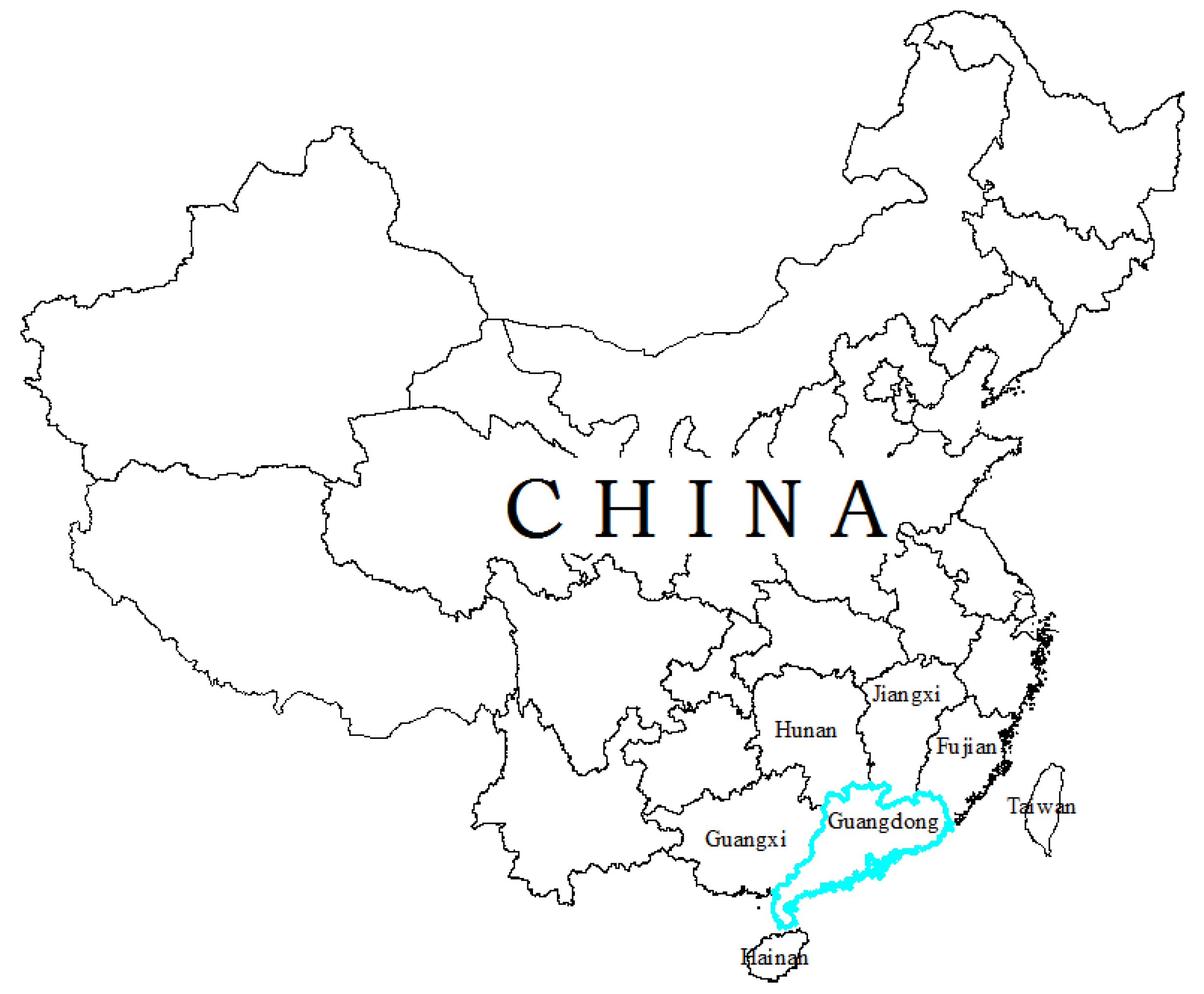

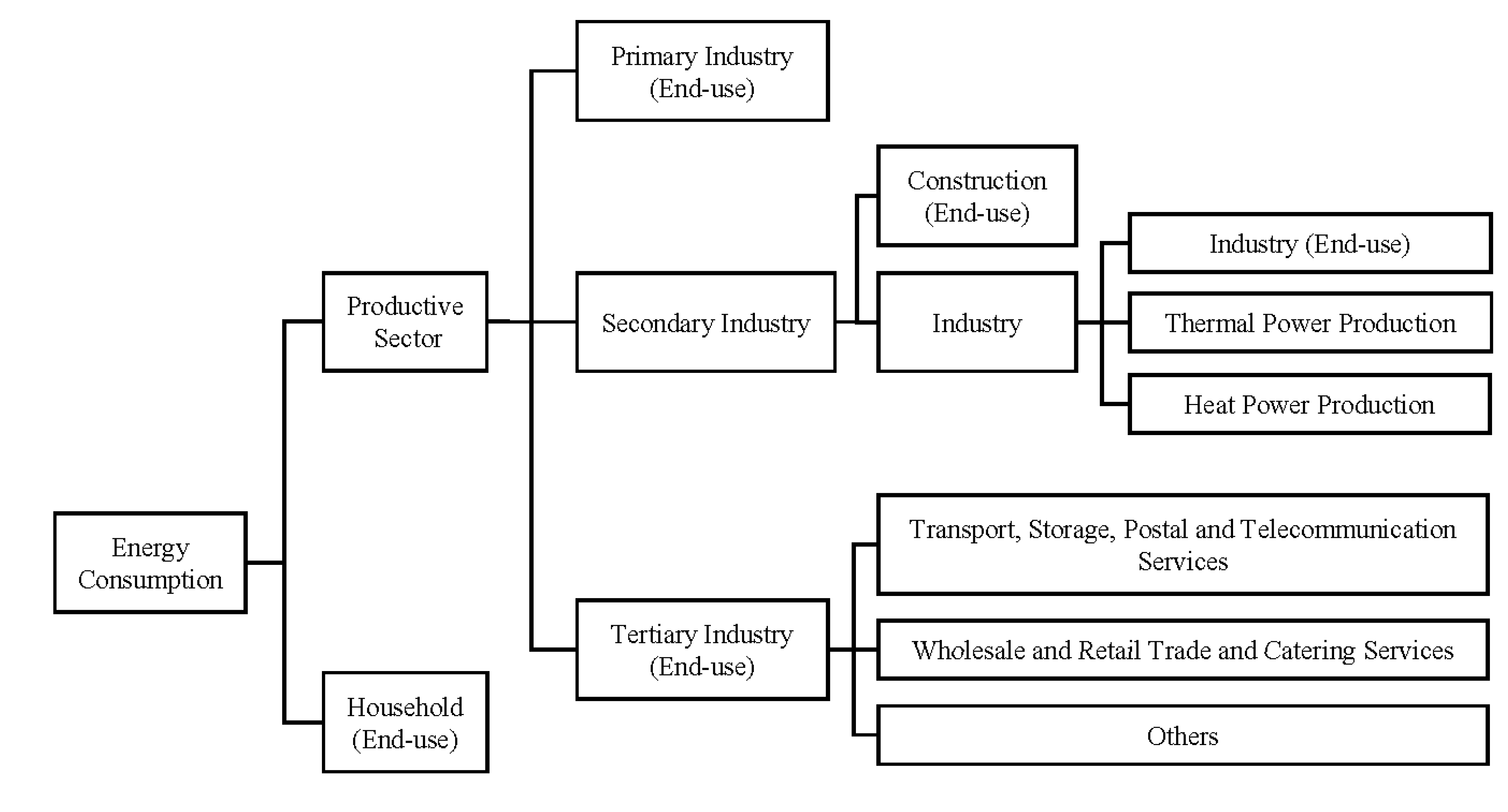

 ,
,





 represent carbon emission coefficient effect, energy mix effect, energy intensity effect, industrial structure effect, and economic output effect respectively.
represent carbon emission coefficient effect, energy mix effect, energy intensity effect, industrial structure effect, and economic output effect respectively.
 , Equation (12) can be rewritten as:
, Equation (12) can be rewritten as: 








